Abstract
The development of new and efficient methods, reagents, and catalysts for the introduction of fluorine atoms or fluorinated moieties in molecular scaffolds has become a topic of paramount importance in organic synthesis. In this framework, the incorporation of the SCF3 group into organic molecule has often led to beneficial effects on the drug’s metabolic stability and bioavailability. Here we report our studies aimed to the stereoselective synthesis of chiral α-SCF3-β−ketoesters featuring a tetrasubstituted stereocenter. The use of a chiral auxiliary was crucial to synthesize enantiopure enamines that were reacted with N-trifluoromethylthio saccharin or phthalimide, to afford enantioenriched α-SCF3-tetrasubstitued β-keto esters. By using a readily available, inexpensive chiral diamine, such as trans-1,2-diaminocyclohexane, the fluorinated products could be obtained in modest to good yields, and, after the removal of the chiral auxiliary, α-substituted- α trifluoromethylthio-β−ketoesters were isolated with high enantioselectivity (up to 91% ee).
1. Introduction
Fluorine atoms or residues are essential constitutive elements in many pharmaceuticals, including very popular drugs such as Lipitor, Odanacatib, and Prozac, or fluoro-hydrocortisone acetate [1,2]. Enhanced lipophilicity, membrane permeability, receptor-binding selectively, and oxidative resistance are some of the attractive features that explain the increasing request of new fluorinated chemical entities, not only in medicinal chemistry (Figure 1) but also in agrochemicals and material chemistry [3,4,5].

Figure 1.
Trifluoromethylthio containing chiral drug candidates.
Modern organic chemists have, therefore, turned their attention to the development of new and efficient methods, reagents, and catalysts for the introduction of a fluorine atom or fluorinated moieties. In this context, the incorporation of the SCF3 group into organic molecules has led often to beneficial effects on the drug’s stability and bioavailability. Being highly lipophilic (Hansch’s hydrophobic parameter π = 1.44) and a strong electron withdrawing group (Hammett constant: σm = 0.40 and σp = 0.50), the SCF3 group has been employed to tune lipophilicity and modify metabolic properties in new drugs [6,7].
Not surprisingly, many SCF3-containing molecules have been recently synthesized [8,9], and different synthetic methods have been developed to realize the trifluoromethylthiolation of organic compounds, exploiting electrophilic, nucleophilic, or radical trifluoromethylthiolating reagents [10,11,12]. Alternative strategies can be used to accomplish the stereoselective synthesis of chiral molecules featuring a trifluoromethylthio group: one possibility is to start from enantiopure, fluorine containing building blocks; alternatively, chiral reagents or chiral catalysts may be employed to accomplish the enantioselective synthesis of the target molecule [13,14,15].
Trifluoromethylthiolated carbonyl derivatives are particularly attractive for their application in medicinal chemistry and as starting building block for the synthesis of functionalized molecules. However, stereoselective strategies to synthetize enantioenriched α-SCF3-substituted carbonyl compounds are still very rare [16].
The first examples of a catalytic enantioselective approach were reported independently by Shen [17] and Rueping [18] in 2013. Both groups studied the trifluoromethylthiolation of indanone-derived β-keto esters catalyzed by Quinine; however, the methodology suffers from severe substrate limitations and work only with cyclic five-membered β−keto esters. Later, Shen published the first chiral trifluoromethylthiolating agent based on the commercially available (1S)-(-)-N-2,10- camphorsultam scaffold. Stereoselective α-trifluoromethylthiolation of β-keto esters, oxindoles, and benzofuranones was successfully achieved in the presence of potassium carbonate as a catalytic base. Excellent results in terms of yield and enantioselection were achieved, with the major disadvantage related to the use of a stoichiometric amount of enantiopure sulfenylating reagent [19]. In 2016, Wu and Sun described a reaction based on an enamine catalysis performed on dihydrocinnamaldehyde in the presence of Hayashi–Jorgensen’s catalyst [20]. Unfortunately, although yields are excellent, the system presents low stereochemical efficiency. In 2018, Wan and co-workers published a diastereo and enantioselective Cu-catalyzed tandem 1,4-addition/trifluoromethylthiolation of acyclic enones [21].
The diastereoselective trifluoromethyltiolation represents a valuable, practical, and efficient alternative to catalytic enantioselective methods. Along these lines, Cahard and coworkers have recently reported the diastereoselective electrophilic trifluoro-methylthiolation of chiral oxazolidinones [22].
Following our interest in the development of novel synthetic strategies for the preparation of fluorinated carbonyl derivatives [16,23], we wish to present our studies aimed to the stereoselective synthesis of α-SCF3-β-ketoesters featuring a quaternary stereocenter.
2. Results and Discussion
In the attempt to develop a catalytic stereoselective α-trifluoromethylthiolation of carbonyl derivatives we decided to take advantage of recent progress in amino catalysis, by generating the enamine intermediate in situ starting from a β-keto ester and a catalytic amount of primary amine in the presence of a sub-stoichiometric quantity of acid. However, despite several catalytic systems being tested, no product formation was observed, or it was observed in very low yields only. Amino-Cinchona derivatives and several amino alcohols, in combination with benzoic acids, acetic, triflic, trifluoroacetic acids among others, were tested with no success.
Therefore, we turned our attention on the use of the preformed enamine, in order to evaluate the feasibility of the approach and the reactivity of such intermediates with N-trifluoromethylthio phthalimide (B) or saccharin (A) as sources of the electrophilic species SCF3+ (Scheme 1).
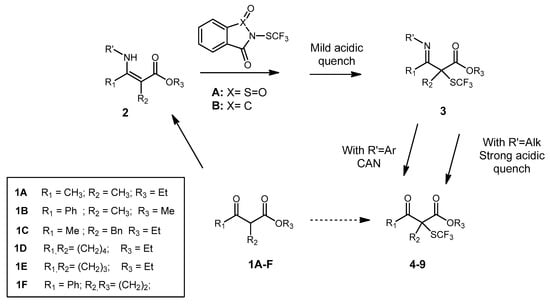
Scheme 1.
Synthetic strategies for α-SCF3 substituted β-imminoesters and β-ketoesters.
Different α-substituted β-keto esters 1A–F were reacted with n-hexylamine or 4-methoxyaniline to generate enamines 2 which were reacted with N-trifluoromethylthio phthalimide or saccharin. For the synthesis of achiral enamines 2a-i and their characterization see the Supporting Information. In preliminary tests on N-hexyl protected enamine of ethyl-2-methyl-3-oxobutanoate 2a as model compound, after a deep investigation of the reaction quench conditions, it was noticed that from the same reaction two different products could be obtained by simple changing the quench procedure (Scheme 2, eq A). When N-hexyl protected enamine was reacted with N-trifluoromethylthio phthalimide B, β-keto ester 4 was formed using a 5M aqueous solution of hydrochloric acid, while β-iminoester 3a instead could be obtained in 70% yield, when a saturated aqueous solution of NH4Cl was employed. However, when the reaction was performed in the presence of N-trifluoromethylthio saccharin (A), even with mild acidic work up, only the β-keto ester 4 was obtained, in higher yields (74%, Scheme 2, eq B).
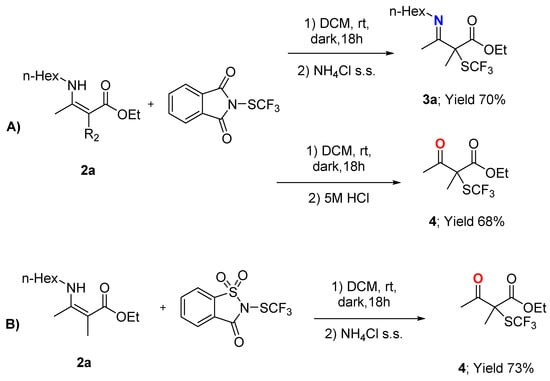
Scheme 2.
Non stereoselective trifluoromethylthiolation of N-alkyl β-iminoesters.
On the other hand, N-4-methoxyhenyl (PMP)-substituted iminoesters were found to be more stable, and only the reaction with cerium ammonium nitrate (CAN) was allowed to remove the aromatic ring to afford the expected β-keto ester. Since it was observed that reaction usually afforded better yields with N-trifluoromethylthio saccharin (A), that was selected as reagent of choice in the further studies.
In a typical experimental procedure, the enamine was dissolved in dry DCM (0.1 M) and the trifluorometyltiolation agent (1.2 eq.) was added. The reaction was stirred at dark at r.t. for 18 h under static nitrogen atmosphere. After the work up (see Experimental section), the crude was purified by filtration on an aluminum oxide basic column.
After a mild acidic work up, the reaction of N-PMP substituted enamines 2b–e afforded the trifluoromethylthio substituted β-iminoesters in good isolated yields; the methodology could also be applied to lactones (products 3b–e, Scheme 3, eq A).
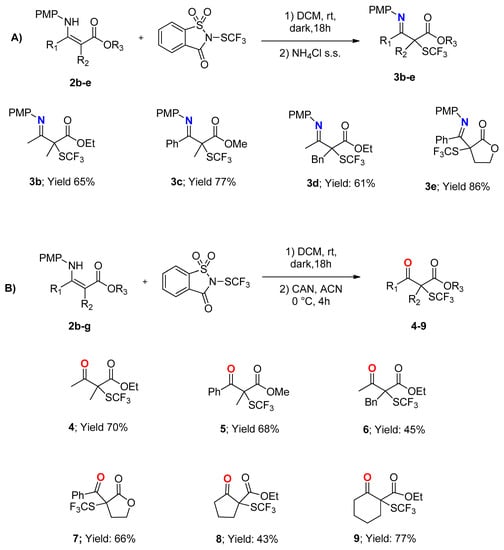
Scheme 3.
Non stereoselective trifluoromethylthiolation of N-PMP β-iminoesters.
Operating with a different experimental procedure, after performing the trifluoromethylthiolation, the crude reaction mixture was reacted with Cerium ammonium nitrate (CAN) to afford directly the β-keto esters 4–9 in overall yields ranging from 43 to 77% (products 4–9, Scheme 3, eq B).
Having demonstrated the chemical efficiency of the methodology, we then investigated the use of chiral amines to generate enantiopure enamines, in the attempt to develop a stereoselective synthesis of fluorinated products 4–9, featuring a quaternary stereocenter, by exploiting the chiral auxiliary approach (Scheme 4). In an exploratory test, the preformed enamine 10, obtained by the reaction of (S)-1-phenylethanamine with ethyl-2-methyl-3-oxobutanoate, was reacted in the presence of N-trifluoromethylthio saccharin and afforded the desired product 4 in 60% yield and modest enantiomeric excess (33% e.e.). When N-(trifluoromethylthio) phthalimide was employed as a trifluoromethylthiolating agent, only traces of the desired product were detectable by 19F NMR.
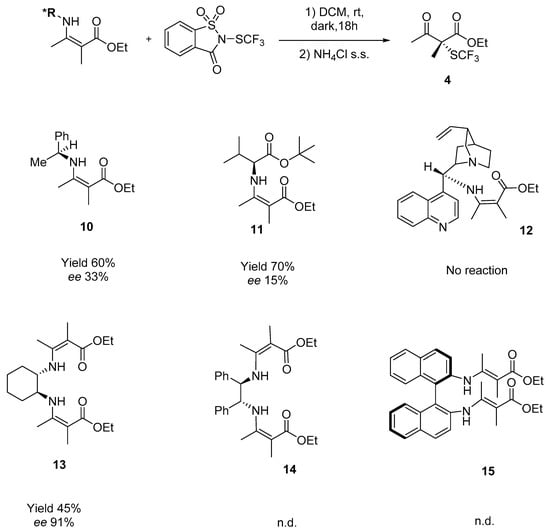
Scheme 4.
Stereoselective trifluoromethylthiolation of β-ketoesters: selection of the best performing chiral auxiliary.
Using ethyl-2-methyl-3-oxobutanoate as a model substrate, other chiral amines were investigated, including aminoesters, Cinchona derivatives, and symmetric 1,2 diamines, such as cyclohexane-1,2-diamine, 1,2-diphenyl ethylendiamine, and 2,2′-binaphthyl diamine. Different enantiopure enamines 11–13 were prepared, while compounds 14 and 15 were obtained in very low yields and their reactivity could not be investigated. When enantiopure enamines 11–13 were reacted at room temperature with N-trifluoromethylthio saccharin, enamine 11 afforded the product in 70% yield but only 15% e.e., while with enamine 12, product formation was not observed. The best results were obtained with the C2-symmetric enamine 13 derived from (1S,2S)-trans-1,2-diaminocyclohexane, that gave β-ketoester 4 in 45% yield and 91% enantioselectivity (Scheme 4). A 24 h reaction time was found to be the best compromise to reach decent yields in a reasonable time; shorter times gave very low yields, while for longer reaction times, decomposition of the reagents led to the formation of byproducts and to a not significant improvement of the yield. We then decided to use the same chiral auxiliary to investigate the application of the method to other substrates (Scheme 5).
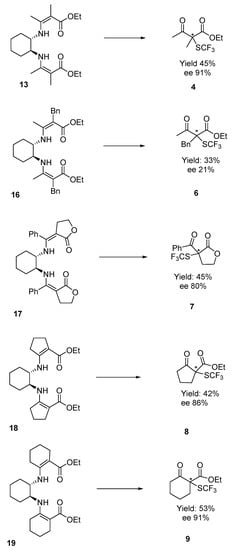
Scheme 5.
Stereoselective trifluoromethylthiolation of β-ketoesters.
While the chiral enamine of β-ketoester 1B could not be isolated as clean product and its reactivity was not studied, the reaction of enamine 16 derived from β-ketoester 1C featuring a benzyl group in α position afforded the expected reaction product 6, although in poor yields and with very low enantioselectivity (33% yield, 21% e.e.). The poor reactivity and the low enantioselection may be ascribed to the stereoelectronic hindrance of the benzyl moiety that would probably obstruct the approach of the trifluoromethyltiolation agent. However, with other ketoesters, featuring an alkyl group in α position, good results were obtained and stereoselectivities higher than 80% were reached. Indeed, β-ketoesters 7–9 were obtained with modest to fair yields but high enantioselectivities, ranging from 80 to 91% e.e.
In conclusion, although the work represents only a preliminary exploration of the use of the chiral auxiliary approach to synthetize chiral fluorinated molecules featuring quaternary stereocenters, it was demonstrated that by using a readily available, inexpensive chiral diamine, such as trans-1,2-diaminocyclohexane, the fluorinated products could be obtained in modest-to-good yields, and, after the removal of the chiral auxiliary, α-substituted- α trifluoromethylthio-β−ketoesters were isolated with up to 91% enantioselectivity. The determination of the absolute configuration was attempted, but it was not possible to obtain solid products for X-ray determination. N-alkyl -imino esters produced in the reactions with the saccharin-based reagent cannot be purified; therefore it was not possible to isolate the products and determine the absolute configuration. Further studies are needed to clarify this point.
3. Experimental
NMR spectra: 1H-NMR, 19F-NMR and 13C-NMR spectra were recorded with instruments at 300 MHz (Bruker Fourier 300 or AMX 300 (Bruker, Billerica, MA, USA)). Proton chemical shifts are reported in ppm (δ) with the solvent reference relative to tetramethylsilane (TMS) employed as the internal standard (CDCl3 δ = 7.26 ppm). 13C NMR spectra were recorded operating at 75 MHz, with complete proton decoupling. Carbon chemical shifts are reported in ppm (δ) relative to TMS with the respective solvent resonance as the internal standard (CDCl3, δ = 77.0 ppm). 19F NMR spectra were recorded operating at 282 MHz. Fluorine chemical shifts are reported in ppm (δ) relative to CF3Cl.
HPLC: For HPLC analyses on chiral stationary phase, to determine enantiomeric excesses, it was used an Agilent Instrument Series 1100 (Agilent, Santa Clara, CA, USA). The specific operative conditions for each product are reported from time to time.
Mass spectra: Mass spectra and accurate mass analysis were carried out on a VG AUTOSPEC- M246 spectrometer (double-focusing magnetic sector instrument with EBE geometry) equipped with EI source or with LCQ Fleet ion trap mass spectrometer, ESI source, with acquisition in positive ionization mode in the mass range 50–2000 m/z.
TLC: Reactions and chromatographic purifications were monitored by analytical thin-layer chromatography (TLC) using silica gel 60 F254 pre-coated glass plates (0.25 mm thickness) and visualized using UV light, vanillin, or KMnO4.
Chromatographic purification: Purification of the products was performed by column chromatography with flash technique (according to the Still method) using as stationary phase silica gel 230–400 mesh (SIGMA ALDRICH) or Aluminium oxide, neutral, Brockmann I 50–200 μm 60A previously deactivated with 6% of H2O.
3.1. Materials
Dry solvents were purchased and stored under nitrogen over molecular sieves (bottles with crown caps).
Commercial grade reagents and solvents were used without further purifications. Ethyl 2-methylacetoacetate (CAS 609-14-3), Ethyl 2-acetyl-3-phenylpropionate (CAS 620-79-1), Ethyl 2-oxocyclopentanecarboxylate (CAS 611-10-9), and Ethyl cyclohexanone-2-carboxylate (CAS 1655-07-8) were purchased by Sigma Aldrich and they were used without further purifications. AgSCF3 (CAS 811-68-7) was purchased by TCI and it was used without further purifications.
3.2. Preparation of Chiral Enamines
The β-keto ester (2.8 mmol, 2.2 eq) was dissolved in 12 mL of toluene (0.24 M) and (1S,2S)-1,2-trans-diaminocyclohexane (1.3 mmol, 1 eq) and p-toluensulfonic acid (0.13 mmol, 0.1 eq) were added. The reaction mixture was stirred at reflux (110 °C) with Dean-Stark apparatus equipped with molecular sieves for 48 h. After this time, the reaction mixture was filtered over a plug of celite and washed with AcOEt, then the solvent was evaporated and the crude was purified by filtration on a silica gel flash column deactivated with trimethylamine (Figure 2).
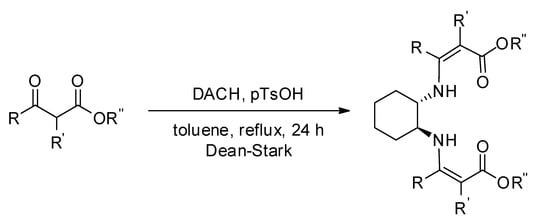
Figure 2.
Synthesis of chiral enamines.
3.2.1. Diethyl 3,3′-((1S,2S)-Cyclohexane-1,2-diylbis(azanediyl))bis(2-methylbut-2-enoate) 13
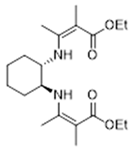
Prepared according to the general procedure. The crude mixture was purified by column chromatography on silica gel (Hex-EtOAc 9:1+ 2% di NEt3) to afford the desired product as a pale-yellow oil in 58% yield.
1H-NMR (300 MHz, CDCl3): δ 9.35 (d, J = 8.2 Hz, 2H), 4.09 (q, J = 7.1 Hz, 4H), 3.19 (m, 2H), 2.03–1.87 (m, 2H), 1.85 (s, 6H), 1.76 (m, 2H), 1.72 (s, 6H), 1.44–1.31 (m, 2H), 1.26 (t, J = 7.1 Hz, 6H), 1.20 (m, 2H) ppm. 13C NMR (75 MHz, CDCl3): δ 171.19, 159.50, 86.75, 58.64, 58.11, 33.40, 24.69, 15.36, 14.67, 12.51 ppm. MS (ESI+) C20H34N2O4: 366.252830 (Calc. Mass 366.251858).
3.2.2. Diethyl 3,3′-((1S,2S)-Cyclohexane-1,2-diylbis(azanediyl))bis(2-benzylbut-2-enoate) 16
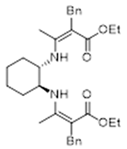
Prepared according to the general procedure. The crude mixture was purified by column chromatography on silica gel (Hex-EtOAc 8:2+ 2% di NEt3) to afford the desired product as a pale-yellow oil in 37% yield.
1H-NMR (300 MHz, CDCl3): δ 9.68 (d, J = 9.0 Hz, 2H), 7.22 (d, J = 7.1 Hz, 4H), 7.17–7.09 (m, 6H), 4.05 (q, J = 7.1 Hz, 4H), 3.60 (dd, J = 57.8, 16.9 Hz, 4H), 3.32–3.15 (m, 2H), 2.02 (d, J = 12.8 Hz, 2H), 1.89 (s, 6H), 1.79 (d, J = 8.1 Hz, 2H), 1.51–1.25 (m, 4H), 1.17 (t, J = 7.1 Hz, 6H) ppm. 13C NMR (75 MHz, CDCl3): δ 171.22, 160.79, 143.07, 127.98, 127.65, 125.14, 90.51, 58.64, 58.03, 33.59, 32.67, 24.71, 15.37, 14.46 ppm. MS (ESI+) C32H42N2O4: 518.314640 (Calc. Mass 518.314458).
3.2.3. (3Z,3′Z)-3,3′-(((1S,2S)-Cyclohexane-1,2-diylbis(azanediyl))bis(phenylmethanylylidene))bis(dihydrofuran-2(3H)-one) 17
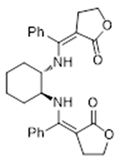
Prepared according to the general procedure. The crude mixture was purified by column chromatography on silica gel (Hex-EtOAc 8:2+ 2% di NEt3) to afford the desired product as a yellow solid in 16% yield.
1H-NMR (300 MHz, CDCl3): δ 7.96 (d, J = 9.3 Hz, 2H), 7.56–7.38 (m, 8H), 7.34 (bs, 2H), 4.22 (t, J = 8.0 Hz, 4H), 2.91–2.72 (m, 2H), 2.56 (td, J = 7.6, 2.5 Hz, 4H), 1.76 (d, J = 13.6 Hz, 2H), 1.49 (d, J = 9.4 Hz, 2H), 1.15 (m, 4H), 0.90 (m, 4H) ppm. 13C NMR (75 MHz, CDCl3): δ 174.27, 159.38, 134.52, 129.16, 127.74, 87.39, 65.72, 58.07, 34.46, 26.92, 24.31 ppm. MS (EI+) C28H30N2O4Na: 481.2109 (Calc. 481.2103).
3.2.4. Diethyl 2,2′-((1S,2S)-Cyclohexane-1,2-diylbis(azanediyl))bis(cyclopent-1-enecarboxylate) 18
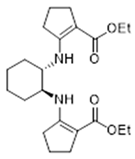
Prepared according to the general procedure. The crude mixture was purified by column chromatography on silica gel (Hex-EtOAc 9:1+ 2% di NEt3) to afford the desired product as a pale yellow oil in 53% yield.
1H-NMR (300 MHz, CDCl3): δ 7.39 (d, J = 5.9 Hz, 2H), 4.18–3.97 (m, 4H), 2.87 (bs, 2H), 2.52 (dt, J = 15.3, 7.5 Hz, 2H), 2.42–2.26 (m, 6H), 2.05–1.93 (m, 2H), 1.80–1.53 (m, 6H), 1.26 (d, J = 1.5 Hz, 4H), 1.22 (td, J = 7.1, 2.7 Hz, 6H) ppm. 13C NMR (75 MHz, CDCl3): δ 168.76, 164.79, 92.77, 60.43, 58.32, 33.36, 32.37, 28.82, 24.85, 21.14, 14.75 ppm. MS (ESI+) C22H34N2O4Na: 413.2414 (Calc. 413.2416).
3.2.5. Diethyl 2,2′-(((1S,2S)-Cyclohexane-1,2-diyl)bis(azanediyl))bis(cyclohex-1-ene-1-carboxylate) 19
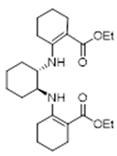
Prepared according to the general procedure. The crude mixture was purified by column chromatography on silica gel (Hex-EtOAc 97:3+ 2% di NEt3) to afford the desired product as a pale yellow oil in 88% yield.
1H-NMR (300 MHz, CDCl3): δ 8.99 (d, J = 9.4 Hz, 2H), 4.05 (qq, J = 10.7, 7.1 Hz, 4H), 3.07 (m, 2H), 2.38–1.62 (m, 16H), 1.53–1.38 (m, 6H), 1.31 (m 4H), 1.20 (t, J = 7.1 Hz, 6H) ppm. 13C NMR (75 MHz, CDCl3): δ 171.07, 159.62, 89.24, 58.49, 57.34, 33.58, 26.55, 25.04, 23.92, 22.49, 22.32, 14.67 ppm. MS (ESI+) C24H38N2O4Na: 441.2731 (Calc. 441.2729).
3.3. General Procedure for of α-SCF3 Substituted β-Imino Esters
The achiral enamine (0.14 mmol, 1 eq) was dissolved in 1.4 mL of dry CH2Cl2 (0.1 M) and the trifluorometyltiolation agent (0.16 mmol, 1.2 eq) was added. The reaction was stirred at dark at r.t. for 18 h under static nitrogen atmosphere. After this time, the reaction mixture was quenched with 2 mL × 2 of NH4Cl and extracted with 2 mL × 2 of CH2Cl2: the combined organic layers were dried over Na2SO4 and concentrated under vacuum. The crude was purified by filtration on a basic aluminum oxide flash column (Brockmann I 50–200 μm 58Å, Figure 3).

Figure 3.
Synthesis of imino esters.
3.3.1. Ethyl 3-((4-Methoxyphenyl)imino)-2-methyl-2-((trifluoromethyl)thio)butanoate 3b

Prepared according to the general procedure. The crude mixture was purified by column chromatography a basic aluminum oxide flash column (Brockmann I 50–200 μm 58Å) (Pentane-CH2Cl2 7:3) to afford the desired product as a colorless oil in 65% yield.
1H NMR (300 MHz, CDCl3) δ 6.88 (d, J = 8.8 Hz, 2H), 6.67 (d, J = 8.8 Hz, 2H), 4.30 (q, J = 7.1 Hz, 2H), 3.80 (s, 3H), 2.01 (s, 3H), 1.87 (s, 3H), 1.32 (t, J = 7.1 Hz, 3H). 13C NMR (75 MHz, CDCl3) δ 170.18, 166.14, 156.69, 142.50, 130.61 (q, J = 309.2 Hz), 120.40, 114.48, 64.57, 63.01, 55.62, 23.51, 16.08, 14.04 ppm. 19F NMR (282 MHz, CDCl3): δ −37.28 ppm. MS (ESI+) C15H18NO3F3S: 349.096590 (Calc. Mass 349.095950).
3.3.2. Methyl 3-((4-Methoxyphenyl)imino)-2-methyl-3-phenyl-2-((trifluoromethyl)thio)propanoate 3c

Prepared according to the general procedure. The crude mixture was purified by column chromatography a basic aluminum oxide flash column (Brockmann I 50–200 μm 58Å;) (Hexane-CH2Cl2-Et2O 80:15:5) afford the desired product as a colorless oil in 78% yield.
1H NMR (300 MHz, CDCl3) δ 7.43–7.19 (m, 2H), 7.09–6.95 (m, 2H), 6.65 (d, J = 1.4 Hz, 5H), 3.81 (s, 3H), 3.71 (s, 3H), 2.00 (s, 3H) ppm. 13C NMR (75 MHz, CDCl3) δ 170.42, 166.10, 156.97, 141.01, 133.82, 130.73 (q, J = 309.8 Hz), 129.34, 128.64, 128.35, 122.89, 113.82, 64.55, 55.40, 53.55, 23.91 ppm. 19F NMR (282 MHz, CDCl3) δ −37.68 ppm. MS (ESI+) C19H18NO3F3S: 397.095520 (Calc. Mass 397.095950).
3.3.3. Ethyl 2-Benzyl-3-((4-methoxyphenyl)imino)-2-((trifluoromethyl)thio)butanoate 3d

Prepared according to the general procedure. The crude mixture was purified by column chromatography a basic aluminum oxide flash column (Brockmann I 50–200 μm 58Å) (Hexane-CH2Cl2 8:2) to afford the desired product as a colorless oil in 61% yield.
1H NMR (300 MHz, CDCl3) δ 7.41–7.14 (m, 5H), 6.84 (d, J = 8.8 Hz, 2H), 6.49 (d, J = 8.8 Hz, 2H), 4.27 (q, J = 7.2 Hz, 2H), 3,79 (s, 3H), 3.79 (d, J = 14.8 Hz, 1H), 3.69 (d, J = 15.1 Hz, 1H), 1.89 (s, 3H), 1.30 (t, J = 7.1 Hz, 3H) ppm. 13C NMR (75 MHz, CDCl3) δ 169.24, 165.04, 156.54, 142.46, 135.17, 130.91, 130.44 (q, J = 309.6 Hz) 128.18, 127.47, 120.09, 114.40, 69.55, 63.06, 55.57, 39.88, 17.38, 13.97 ppm. 19F NMR (282 MHz, CDCl3) δ −37.04 ppm. MS (ESI+) C21H22NO3F3S: 425.126790 (Calc. Mass 425.127250).
3.3.4. (E)-3-(((4-Methoxyphenyl)imino)(phenyl)methyl)-3-((trifluoromethyl)thio)dihydrofuran-2(3H)-one 3e
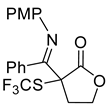
Prepared according to the general procedure. The crude mixture was purified by column chromatography a basic aluminum oxide flash column (Brockmann I 50–200 μm 58Å) (Hexane-CH2Cl2 8:2) to afford the desired product as a colorless oil in 86% yield.
1H NMR (300 MHz, CDCl3) δ = 7.30 (m, 3H), 7.13 (m, 2H), 6.62 (m, 4H), 4.48 (td, 1H, J = 8.9Hz, J = 3.3Hz), 4.21 (m, 1H), 3.70 (s, 3H), 3.50 (m, 1H), 3.00 (m, 1H) ppm. 13C NMR (75 MHz, CDCl3) δ = 172.30, 162.59, 157.00, 140.87, 133.24, 131.03 (q, J = 309.6 Hz), 129.43, 128.72, 128.50, 122.75, 113.76, 66.88, 63.03, 55.28, 34.71 ppm. 19F NMR (282 MHz, CDCl3) δ = −36.87 (s, 3F) ppm. MS (ESI+) C19H16NO3F3SH: 396.0877 (Calc. Mass 396.0881).
3.3.5. Ethyl 3-(Hexylimino)-2-methyl-2-((trifluoromethyl)thio)butanoate 3a

Prepared according to the general procedure using the N-SCF3 phthalimide as trifluorometyltiolation agent. The crude mixture was purified by column chromatography a basic aluminum oxide flash column (Brockmann I 50–200 μm 58Å) (Pentane-CH2Cl2 8:2) to afford the desired product as a colorless oil in 70% yield.
1H NMR (300 MHz, CDCl3) δ 4.24 (q, J = 7.1 Hz, 2H), 3.30 (td, J = 7.4, 2.1 Hz, 2H), 1.86 (s, 3H), 1.82 (s, 3H), 1.70–1.53 (m, 2H), 1.41–1.21 (m, 9H), 0.94–0.83 (m, 3H) ppm. 13C NMR (75 MHz, CDCl3) δ 170.68, 163.34, 130.91 (q, J = 309.1 Hz), 65.06, 62.65, 51.61, 31.76, 30.14, 29.84, 27.16, 23.28, 22.75, 14.18, 13.98 ppm. 19F NMR (282 MHz, CDCl3) δ −37.77 ppm. MS (ESI+) C12H19NOF3S: 282.113910 (Calc. Mass 282.113946).
3.4. General Non Enantioselective Procedure for α-SCF3 SUBSTITUTED β-Ketoesters
The achiral enamine (0.14 mmol, 1 eq) was dissolved in 1.4 mL of dry CH2Cl2 (0.1 M) and the trifluorometyltiolation agent (0.16 mmol, 1.2 eq) was added. The reaction was stirred at dark at r.t. for 18 h under static nitrogen atmosphere. After this time, the reaction mixture was quenched with 2 mL × 2 of H2O and extracted with 2 mL × 2 of CH2Cl2: the combined organic layers were dried over Na2SO4 and concentrated under vacuum. The crude was dissolved in 5.4 mL of acetonitrile (0.025 M), a solution of CAN (4.2 mmol, 3 eq) in 1.5 mL of H2O was added at 0 °C, and the stirring was continued at 0 °C for 4 h. Then, after this time, the reaction mixture was quenched with 5 mL of H2O and extracted with 5 mL of CH2Cl2: the combined organic layers were dried over Na2SO4 and concentrated under vacuum. The crude was purified by filtration on silica gel flash column (Figure 4).

Figure 4.
Synthesis of β ketoesters.
3.5. General Enantioselective Procedure for Chiral α-SCF3 Substituted β-Ketoesters
The chiral enamine (0.14 mmol, 1 eq), was dissolved in 1.4 mL of dry CH2Cl2 (0.1 M) and N-trifluoromethylthio saccharin (0.16 mmol, 1.2 eq) was added. The reaction mixture was stirred at dark at r.t. for 18 h under static nitrogen atmosphere. After this time, the reaction mixture was quenched with 2 mL × 2 of H2O and extracted with 2 mL × 2 of CH2Cl2: the combined organic layers were dried over Na2SO4 and concentrated under vacuum. The crude was purified by filtration on silica gel flash column (Figure 5).

Figure 5.
Enantioselective Synthesis of β ketoesters.
3.5.1. Ethyl 2-Methyl-3-oxo-2-((trifluoromethyl)thio)butanoate 4

Prepared according to the general procedure. The crude mixture was purified by column chromatography on silica gel (Hexane-CH2Cl2 7:3) to afford the desired product as a colorless oil in 68% yield.
1H-NMR (300 MHz, CDCl3): δ 4.31 (q, J = 7.1 Hz, 2H), 2.35 (s, 3H), 1.90 (s, 3H), 1.33 (t, J = 7.1 Hz, 3H) ppm. 13C NMR (75 MHz, CDCl3): δ 198.17, 167.99, 129.58 (q, J = 308.6 Hz), 65.76, 63.41, 24.89, 21.52, 13.75 ppm. 19F NMR (282 MHz, CDCl3) δ −36.75 ppm. MS (ESI+) C8H11O3F3SNa: 267.0283 (Calc. Mass 267.0279).
3.5.2. Methyl 2-Methyl-3-oxo-3-phenyl-2-((trifluoromethyl)thio)propanoate 5

Prepared according to the general procedure. The crude mixture was purified by column chromatography on silica gel (Hexane-CH2Cl2 7:3) to afford the desired product as a colorless oil in 68% yield.
1H-NMR (300 MHz, CDCl3): δ 7.92 (d, J = 7.5 Hz, 2H), 7.58 (t, J = 7.4 Hz, 1H), 7.45 (t, J = 7.7 Hz, 2H), 3.73 (s, 3H), 2.11 (s, 3H) ppm. 13C NMR (75 MHz, CDCl3): δ 190.76, 170.00, 133.78, 133.23, 129.70 (q, J = 308.8 Hz), 129.07, 128.79, 63.83, 53.91, 24.33 ppm. 19F NMR (282 MHz, CDCl3) δ −36.70 ppm. MS (EI+) C12H11F3O3SH 293.0463 (Calc. Mass 293.0459).
3.5.3. Ethyl 2-Benzyl-3-oxo-2-((trifluoromethyl)thio)butanoate 6

Prepared according to the general procedure. The crude mixture was purified by column chromatography on silica gel (Hexane-CH2Cl2 7:3) to afford the desired product as a colorless oil in 41% yield.
1H-NMR (300 MHz, CDCl3): δ 7.40–7.23 (m, 3H), 7.19 (dd, J = 7.0, 2.5 Hz, 2H), 4.19 (qq, J = 10.7, 7.2 Hz, 2H), 3.55 (dd, J = 55.1, 14.9 Hz, 2H), 2.36 (s, 3H), 1.22 (t, J = 7.2 Hz, 3H) ppm. 13C NMR (75 MHz, CDCl3): δ 197.57, 166.66, 134.27, 130.42, 129.36 (q, J = 309.3 Hz), 128.30, 127.56, 71.13, 63.41, 38.91, 29.69, 25.88, 13.68 ppm. 19F NMR (282 MHz, CDCl3) δ −36.39 ppm. MS (ESI+) C14H15F3O3SH: 321.0770 (Calc. Mass: 321.0772).
The enantiomeric excess was determined by HPLC on chiral stationary phase with Daicel Chiralpack OJ-H 10 µm column, eluent Hexane/iPrOH 99-1, flow rate 0.8 mL/min, pressure: 31 bar λ = 210 nm, τminor: 8.177 min, τmajor: 8.790 min.
3.5.4. 3-Benzoyl-3-((trifluoromethyl)thio)dihydrofuran-2(3H)-one 7

Prepared according to the general procedure. The crude mixture was purified by column chromatography on silica gel (Hexane-AcOEt 9:1-> 8:2) to afford the desired product as a colorless oil in 45% yield.
1H-NMR (300 MHz, CDCl3): δ 8.31 (d, J = 8.2 Hz, 2H), 7.75–7.53 (m, 1H), 7.47 (t, J = 7.7 Hz, 2H), 4.55 (td, J = 8.8, 1.8 Hz, 1H), 4.41 (ddd, J = 10.1, 8.9, 5.8 Hz, 1H), 3.62 (dd, J = 13.1, 5.9 Hz, 1H), 2.95–2.78 (m, 1H) ppm. 13C NMR (75 MHz, CDCl3): δ 188.58, 170.03, 134.09, 133.29, 130.73, 129.12 (q, J = 309.6 Hz), 128.37, 68.22, 62.08, 36.88 ppm. 19F NMR (282 MHz, CDCl3) δ −37.28 ppm. MS (ESI+) C12H9O3F3SNa: 313.0124 (Calc. Mass 313.0122).
The enantiomeric excess was determined by HPLC on chiral stationary phase with Phenomenex Lux 3 µm Amylose-1 column, eluent Hexane/iPrOH 98-2, flow rate 0.8 mL/min, pressure: 63 bar λ = 260 nm, τminor 1: 10.195 min, τmajor 2: 10.847 min.
3.5.5. Ethyl 2-Oxo-1-((trifluoromethyl)thio)cyclopentanecarboxylate 8

Prepared according to the general procedure. The crude mixture was purified by column chromatography on silica gel (Pentane-CH2Cl2 6:4) to afford the desired product as a pale-yellow oil in 39% yield. All analytical data are in agreement with the [24].
1H-NMR (300 MHz, CDCl3): 4.44–4.14 (m, 2H), 3.07–2.86 (m, 1H), 2.56–2.46 (m, 2H), 2.44–2.32 (m, 1H), 2.28–2.06 (m, 2H), 1.32 (t, J = 7.1 Hz, 3H) ppm. 13C NMR (75 MHz, CDCl3): δ 206.56, 166.93, 129.56 (q, J = 309.2 Hz), 63.67, 63.27, 36.01, 35.75, 19.73, 13.83 ppm. 19F NMR (282 MHz, CDCl3) δ −36.78 ppm. MS (ESI+) C9H11O3F3SNa: 279.0277 (Calc. Mass 279.0279).
The enantiomeric excess was determined by HPLC on chiral stationary phase with Daicel Chiralpack OD-H 10µm column, eluent Hexane/iPrOH 98-2, flow rate 0.8 mL/min, pressure: 32 bar λ = 210 nm, τminor: 7.431 min, τmajor: 8.781 min.
3.5.6. Ethyl 2-Oxo-1-((trifluoromethyl)thio)cyclohexanecarboxylate 9

Prepared according to the general procedure. The crude mixture was purified by column chromatography on silica gel (Hexane-CH2Cl2 7:3) to afford the desired product as a colorless oil in 77% yield. All analytical data are in agreement with the [24].
1H-NMR (300 MHz, CDCl3): δ 4.45–4.19 (m, 2H), 3.09 (d, J = 13.8 Hz, 1H), 2.72–2.59 (m, 1H), 2.45 (td, J = 13.8, 5.9 Hz, 1H), 2.19–1.98 (m, 2H), 1.97–1.66 (m, 3H), 1.32 (t, J = 7.1 Hz, 3H) ppm. 13C NMR (75 MHz, CDCl3): δ 201.12, 167.09, 130.05 (q, J = 308.7 Hz), 67.48, 62.96, 40.28, 38.39, 27.13, 22.89, 13.73 ppm. 19F NMR (282 MHz, CDCl3) δ −36.21 ppm
The enantiomeric excess was determined by HPLC on chiral stationary phase with Phenomenex Lux 3 µm Cellulose-1 column, eluent Hexane/iPrOH 98-2, flow rate 0.8 mL/min, pressure: 63 bar λ = 210 nm, τminor 1: 10. 287 min τmajor 2: 10. 749 min.
4. Conclusions
Organic chemists are always looking for new methodologies to stereoselectively introduce fluorinated residues in organic molecules. Here we have reported our studies, which aimed to synthesize enantioenriched α-SCF3-β−ketoesters featuring a quaternary stereocenter. The use of a chiral auxiliary was crucial to synthesize enantiopure enamines which were reacted with N-trifluoromethylthio saccharin to afford enantiomerically enriched α-SCF3-tetrasubstitued β-keto esters and β-imino esters, depending on the work up at the end of the reaction. By using a readily available, inexpensive chiral diamine, such as trans-1,2-diaminocyclohexane, the fluorinated products could be obtained in modest-to-good yields, and, after the removal of the chiral auxiliary, α-substituted- α trifluoromethylthio-β−ketoesters were isolated with up to 91% enantioselectivity.
Supplementary Materials
The following are available online at https://www.mdpi.com/2073-8994/13/1/92/s1, Synthesis of starting materials, general procedures for the synthesis of chiral imino esters and ketoesters; products characterization; NMR, GC, HPLC traces.
Author Contributions
M.F.B., C.F. and E.M. performed the synthetic works. A.P. and L.R. analyzed the results. M.B. designed the experiments of the project and supervised the whole studies reported in the manuscript. All authors have read and agreed to the published version of the manuscript.
Funding
This research was funded by MUR, Grant the project PRIN 2017 “SURSUMCAT” and by ITN-EID project Marie Sklodowska-Curie Actions Innovative Training Network—TECHNOTRAIN H2020-MSCA-ITN-2018 Grant Agreement 812944—www.technotrain-ITN.eu.
Institutional Review Board Statement
Not applicable.
Informed Consent Statement
Not applicable.
Acknowledgments
M.F.B. acknowledges UNIMI for a PhD fellowship.
Conflicts of Interest
The authors declare no conflict of interest.
References
- Zhou, Y.; Wang, J.; Gu, Z.; Wang, S.; Zhu, W.; Aceña, J.L.; Soloshonok, V.A.A.; Izawa, K.; Liu, H. Next Generation of Fluorine-Containing Pharmaceuticals, Compounds Currently in Phase II–III, Clinical Trials of Major Pharmaceutical Companies: New Structural Trends and Therapeutic Areas. Chem. Rev. 2016, 116, 422–518. [Google Scholar] [CrossRef] [PubMed]
- Ojima, I. Fluorine in Medicinal Chemistry and Chemical Biology; Wiley-Blackwell: Chichester, UK, 2009. [Google Scholar]
- Cahard, D.; Bizet, V. The influence of fluorine in asymmetric catalysis. Chem. Soc. Rev. 2014, 43, 135–147. [Google Scholar] [CrossRef] [PubMed]
- Moschner, J.; Stulberg, V.; Fernandes, R.; Huhmann, S.; Leppkes, J.; Koksch, B. Approaches to Obtaining Fluorinated α-Amino Acids. Chem. Rev. 2019, 119, 10718–10801. [Google Scholar] [CrossRef] [PubMed]
- Jeschke, P. The Unique Role of Halogen Substituents in the Design of Modern Agrochemicals. Pest Manag. Sci. 2010, 66, 10–27. [Google Scholar] [CrossRef] [PubMed]
- Leroux, F.; Jeschke, P.; Schlosser, M. α-Fluorinated Ethers, Thioethers, and Amines: Anomerically Biased Species. Chem. Rev. 2005, 105, 827–856. [Google Scholar] [CrossRef] [PubMed]
- Meanwell, N.A. Synopsis of some recent tactical application of bioisosteres in drug design. J. Med. Chem. 2011, 54, 2529–2591. [Google Scholar] [CrossRef]
- Purser, S.; Moore, P.R.; Swallow, S.; Gouverneur, V. Fluorine in medicinal chemistry. Chem. Soc. Rev. 2008, 37, 320–330. [Google Scholar] [CrossRef]
- Wang, J.; Sanchez-Rosello, M.; Acena, J.L.; del Pozo, C.; Sorochinsky, A.E.; Fustero, S.; Soloshonok, V.A.; Liu, H. Fluorine in pharmaceutical industry: Fluorine-containing drugs introduced to the market in the last decade (2001–2011). Chem. Rev. 2014, 114, 2432–2506. [Google Scholar] [CrossRef]
- Hardy, M.A.; Chachignon, H.; Cahard, D. Advances in Asymmetric Di-and Trifluoromethylthiolation, and Di- and Trifluoromethoxylation Reactions. Asian J. Org. Chem. 2019, 8, 591–609. [Google Scholar] [CrossRef]
- Sicignano, M.; Rodríguez, R.I.; Capaccio, V.; Borello, F.; Cano, R.; De Riccardis, F.; Bernardi, L.; Díaz-Tendero, S.; Della Sala, G.; Alemán, J. Asymmetric trifluoromethylthiolation of azlactones under chiral phase transfer catalysis. Org. Biomol. Chem. 2020, 18, 2914–2920. [Google Scholar] [CrossRef]
- Capaccio, V.; Sicignano, M.; Rodríguez, R.I.; Della Sala, G.; Alemán, J. Asymmetric Synthesis of α-Trifluoromethylthio-β-Amino Acids under Phase Transfer Catalysis. Org. Lett. 2020, 22, 219–223. [Google Scholar] [CrossRef] [PubMed]
- Liang, Y.; Ji, J.; Zhang, X.; Jiang, Q.; Luo, J.; Zhao, X. Enantioselective Construction of Axially Chiral Amino Sulfide Vinyl Arenes by Chiral Sulfide Catalyzed Electrophilic Carbothiolation of Alkynes. Angew. Chem. Int. Ed. 2020, 59, 4959–4964. [Google Scholar] [CrossRef] [PubMed]
- Trost, B.M.; Hung, C.-I.J.; Mata, G.; Liu, Y.; Lu, Y.; Gnanamani, E. Direct Enantio- and Diastereoselective Zn-ProPhenol-Catalyzed Mannich Reactions of CF3- and SCF3-Substituted Ketones. Org. Lett. 2020, 22, 2437–2441. [Google Scholar] [CrossRef] [PubMed]
- Eitzinger, A.; Brière, J.F.; Cahard, D.; Waser, M. Enantioselective catalytic synthesis of α-aryl-α-SCF3-β2,2-amino acids. Org. Biomol. Chem. 2020, 18, 405–408. [Google Scholar] [CrossRef]
- Rossi, S.; Puglisi, A.; Raimondi, L.; Benaglia, M. Synthesis of alpha-trifluoromethylthio carbonyl compounds: A survey of the methods for the direct introduction of the SCF3 group on to organic molecules. ChemCatChem 2018, 10, 2717–2733. [Google Scholar] [CrossRef]
- Wang, X.; Yang, T.; Cheng, X.; Shen, Q. Enantioselective electrophilic trifluoromethylthiolation of β-ketoesters: A case of reactivity and selectivity bias for organocatalysis. Angew. Chem. Int. Ed. 2013, 52, 12860–12864. [Google Scholar] [CrossRef]
- Bootwicha, T.; Liu, X.; Pluta, R.; Atodiresei, I.; Rueping, M. N-trifluoromethylthiophthalimide: A stable electrophilic SCF3-reagent and its application in the catalytic asymmetric. Angew. Chem. Int. Ed. 2013, 52, 12856–12859. [Google Scholar] [CrossRef]
- Zhang, H.; Leng, X.; Wan, X.; Shen, Q. (1S)-(−)-N-Trifluoromethylthio-2,10-camphorsultam and its derivatives: Easily available, optically pure reagents for asymmetric trifluoromethylthiolation. Org. Chem. Front. 2017, 4, 1051–1057. [Google Scholar] [CrossRef]
- Hu, L.Q.; Wu, M.H.; Wan, H.X.; Wang, J.; Wang, G.Q.; Guo, H.B.; Sun, S.F. Efficient catalytic α-trifluoromethylthiolation of aldehydes. New J. Chem. 2016, 40, 6550–6553. [Google Scholar] [CrossRef]
- Jin, M.Y.; Li, Y.; Huang, R.; Zhou, Y.; Chung, L.W.; Wan, J. Catalytic asymmetric trifluoro-methylthiolation of carbonyl compounds via a diastereo and enantioselective Cu-catalyzed tandem reaction. Chem. Commun. 2018, 54, 4581–4584. [Google Scholar] [CrossRef]
- Chachignon, H.; Kondrashov, E.V.; Cahard, D. Diastereoselective Electrophilic Trifluoro-methylthiolation of Chiral Oxazolidinones: Access to Enantiopure α-SCF3 Alcohols. Adv. Synth. Catal. 2018, 360, 965–971. [Google Scholar] [CrossRef]
- Abubakar, S.S.; Benaglia, M.; Rossi, S.; Annunziata, R. Organocatalytic trifluoro-methylthiolation of silylenol ethers: Batch vs. continuous flow reactions. Catal. Today 2018, 308, 94–101. [Google Scholar] [CrossRef]
- Yang, X.; Zheng, K.; Zhang, C. Electrophilic Hypervalent Trifluoromethylthio-Iodine(III) Reagent. Org. Lett. 2020, 22, 2026–2031. [Google Scholar] [CrossRef] [PubMed]
Publisher’s Note: MDPI stays neutral with regard to jurisdictional claims in published maps and institutional affiliations. |
© 2021 by the authors. Licensee MDPI, Basel, Switzerland. This article is an open access article distributed under the terms and conditions of the Creative Commons Attribution (CC BY) license (http://creativecommons.org/licenses/by/4.0/).